2012 NISSAN CUBE engine overheat
[x] Cancel search: engine overheatPage 247 of 331
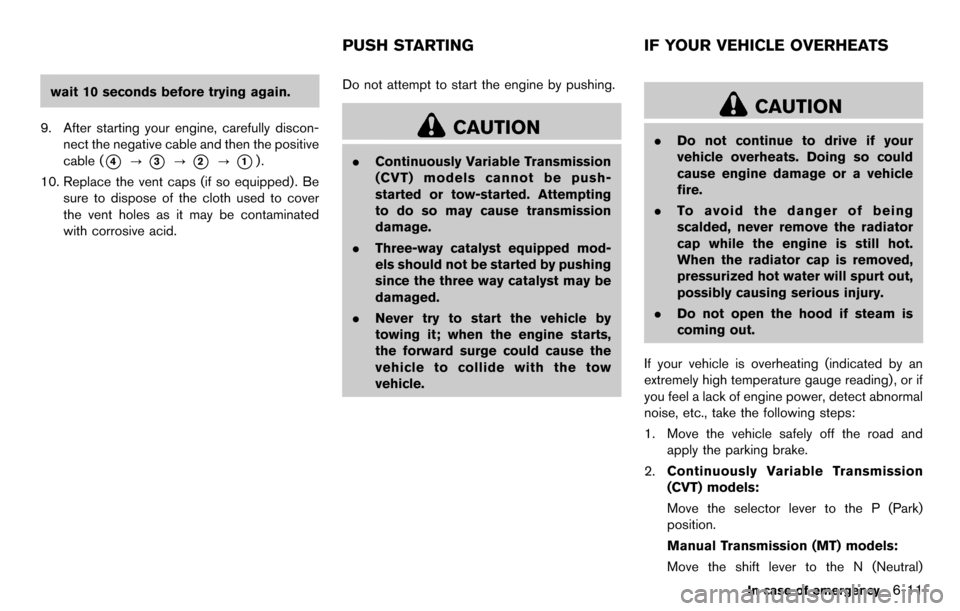
wait 10 seconds before trying again.
9. After starting your engine, carefully discon- nect the negative cable and then the positive
cable (
*4?*3?*2?*1).
10. Replace the vent caps (if so equipped). Be sure to dispose of the cloth used to cover
the vent holes as it may be contaminated
with corrosive acid. Do not attempt to start the engine by pushing.
CAUTION
.
Continuously Variable Transmission
(CVT) models cannot be push-
started or tow-started. Attempting
to do so may cause transmission
damage.
. Three-way catalyst equipped mod-
els should not be started by pushing
since the three way catalyst may be
damaged.
. Never try to start the vehicle by
towing it; when the engine starts,
the forward surge could cause the
vehicle to collide with the tow
vehicle.
CAUTION
.Do not continue to drive if your
vehicle overheats. Doing so could
cause engine damage or a vehicle
fire.
. To avoid the danger of being
scalded, never remove the radiator
cap while the engine is still hot.
When the radiator cap is removed,
pressurized hot water will spurt out,
possibly causing serious injury.
. Do not open the hood if steam is
coming out.
If your vehicle is overheating (indicated by an
extremely high temperature gauge reading) , or if
you feel a lack of engine power, detect abnormal
noise, etc., take the following steps:
1. Move the vehicle safely off the road and apply the parking brake.
2. Continuously Variable Transmission
(CVT) models:
Move the selector lever to the P (Park)
position.
Manual Transmission (MT) models:
Move the shift lever to the N (Neutral)
In case of emergency6-11
PUSH STARTING IF YOUR VEHICLE OVERHEATS
Page 269 of 331
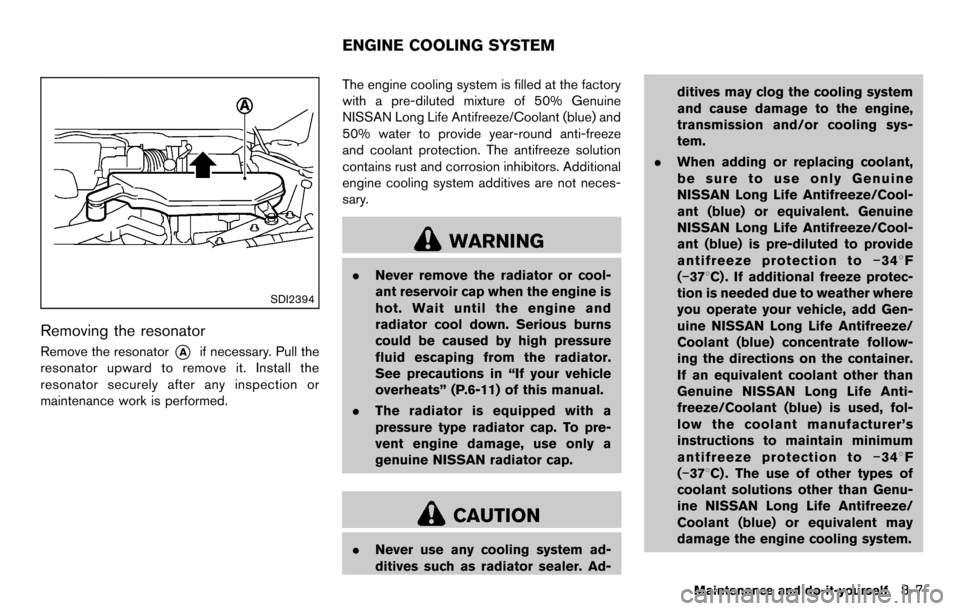
SDI2394
Removing the resonator
Remove the resonator*Aif necessary. Pull the
resonator upward to remove it. Install the
resonator securely after any inspection or
maintenance work is performed. The engine cooling system is filled at the factory
with a pre-diluted mixture of 50% Genuine
NISSAN Long Life Antifreeze/Coolant (blue) and
50% water to provide year-round anti-freeze
and coolant protection. The antifreeze solution
contains rust and corrosion inhibitors. Additional
engine cooling system additives are not neces-
sary.
WARNING
.
Never remove the radiator or cool-
ant reservoir cap when the engine is
hot. Wait until the engine and
radiator cool down. Serious burns
could be caused by high pressure
fluid escaping from the radiator.
See precautions in “If your vehicle
overheats” (P.6-11) of this manual.
. The radiator is equipped with a
pressure type radiator cap. To pre-
vent engine damage, use only a
genuine NISSAN radiator cap.
CAUTION
.Never use any cooling system ad-
ditives such as radiator sealer. Ad- ditives may clog the cooling system
and cause damage to the engine,
transmission and/or cooling sys-
tem.
. When adding or replacing coolant,
be sure to use only Genuine
NISSAN Long Life Antifreeze/Cool-
ant (blue) or equivalent. Genuine
NISSAN Long Life Antifreeze/Cool-
ant (blue) is pre-diluted to provide
antifreeze protection to −348 F
(−378C) . If additional freeze protec-
tion is needed due to weather where
you operate your vehicle, add Gen-
uine NISSAN Long Life Antifreeze/
Coolant (blue) concentrate follow-
ing the directions on the container.
If an equivalent coolant other than
Genuine NISSAN Long Life Anti-
freeze/Coolant (blue) is used, fol-
low the coolant manufacturer’s
instructions to maintain minimum
antifreeze protection to −348 F
(−378C) . The use of other types of
coolant solutions other than Genu-
ine NISSAN Long Life Antifreeze/
Coolant (blue) or equivalent may
damage the engine cooling system.
Maintenance and do-it-yourself8-7
ENGINE COOLING SYSTEM
Page 270 of 331

8-8Maintenance and do-it-yourself
.The life expectancy of the factory-fill
coolant is 105,000 miles (168,000
km) or 7 years. Mixing any other
type of coolant other than Genuine
NISSAN Long Life Antifreeze/Cool-
ant (blue) , including Genuine
NISSAN Long Life Antifreeze/Cool-
ant (green) , or the use of non-
distilled water will reduce the life
expectancy of the factory-fill cool-
ant. Refer to the NISSAN Service
and Maintenance Guide for more
details.
SDI2385
CHECKING ENGINE COOLANT LEVEL
Check the coolant level in the reservoir when
the engine is cold. If the coolant level is below
the MIN level
*2, open the reservoir cap and
add coolant up to the MAX level
*1. If the
reservoir is empty, check the coolant level in the
radiator when the engine is cold. If there is
insufficient coolant in the radiator, fill the radiator
with coolant up to the filler opening and also add
it to the reservoir up to the MAX level
*1.
Tighten the cap securely after adding engine
coolant.
If the cooling system frequently requires
coolant, have it checked by a NISSAN
dealer.
CHANGING ENGINE COOLANT
Major cooling system repairs should be per-
formed by a NISSAN dealer. The service
procedures can be found in the appropriate
NISSAN Service Manual.
Improper servicing can result in reduced
heater performance and engine overheat-
ing.
WARNING
. To avoid the danger of being
scalded, never change the coolant
when the engine is hot.
. Never remove the radiator cap when
the engine is hot. Serious burns
could be caused by high pressure
fluid escaping from the radiator.
. Avoid direct skin contact with used
coolant. If skin contact is made,
wash thoroughly with soap or hand
cleaner as soon as possible.
. Keep coolant out of reach of chil-
dren and pets.
Engine coolant must be disposed of properly.
Check your local regulations.
Page 306 of 331
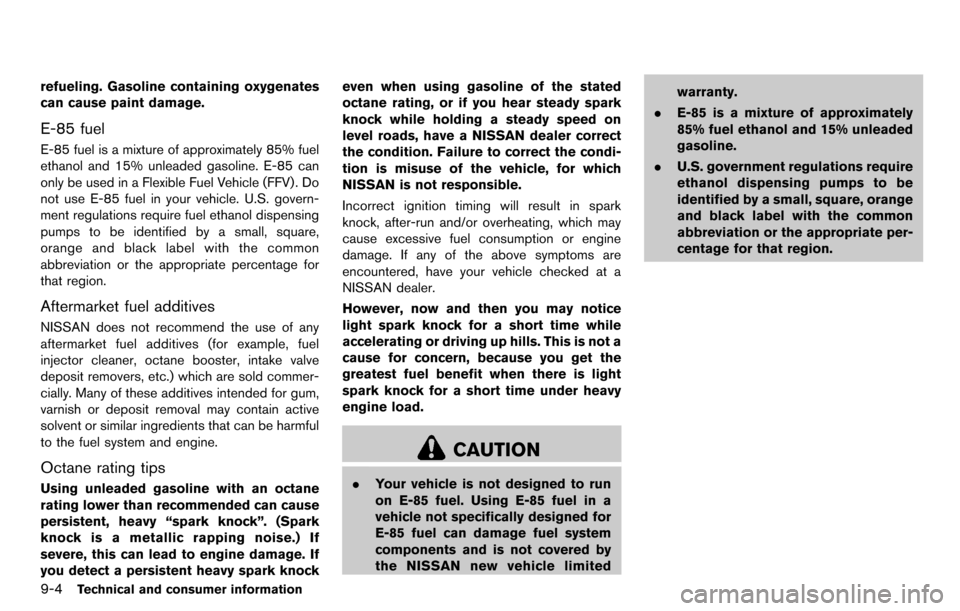
9-4Technical and consumer information
refueling. Gasoline containing oxygenates
can cause paint damage.
E-85 fuel
E-85 fuel is a mixture of approximately 85% fuel
ethanol and 15% unleaded gasoline. E-85 can
only be used in a Flexible Fuel Vehicle (FFV) . Do
not use E-85 fuel in your vehicle. U.S. govern-
ment regulations require fuel ethanol dispensing
pumps to be identified by a small, square,
orange and black label with the common
abbreviation or the appropriate percentage for
that region.
Aftermarket fuel additives
NISSAN does not recommend the use of any
aftermarket fuel additives (for example, fuel
injector cleaner, octane booster, intake valve
deposit removers, etc.) which are sold commer-
cially. Many of these additives intended for gum,
varnish or deposit removal may contain active
solvent or similar ingredients that can be harmful
to the fuel system and engine.
Octane rating tips
Using unleaded gasoline with an octane
rating lower than recommended can cause
persistent, heavy “spark knock”. (Spark
knock is a metallic rapping noise.) If
severe, this can lead to engine damage. If
you detect a persistent heavy spark knockeven when using gasoline of the stated
octane rating, or if you hear steady spark
knock while holding a steady speed on
level roads, have a NISSAN dealer correct
the condition. Failure to correct the condi-
tion is misuse of the vehicle, for which
NISSAN is not responsible.
Incorrect ignition timing will result in spark
knock, after-run and/or overheating, which may
cause excessive fuel consumption or engine
damage. If any of the above symptoms are
encountered, have your vehicle checked at a
NISSAN dealer.
However, now and then you may notice
light spark knock for a short time while
accelerating or driving up hills. This is not a
cause for concern, because you get the
greatest fuel benefit when there is light
spark knock for a short time under heavy
engine load.
CAUTION
.
Your vehicle is not designed to run
on E-85 fuel. Using E-85 fuel in a
vehicle not specifically designed for
E-85 fuel can damage fuel system
components and is not covered by
the NISSAN new vehicle limited warranty.
. E-85 is a mixture of approximately
85% fuel ethanol and 15% unleaded
gasoline.
. U.S. government regulations require
ethanol dispensing pumps to be
identified by a small, square, orange
and black label with the common
abbreviation or the appropriate per-
centage for that region.
Page 324 of 331
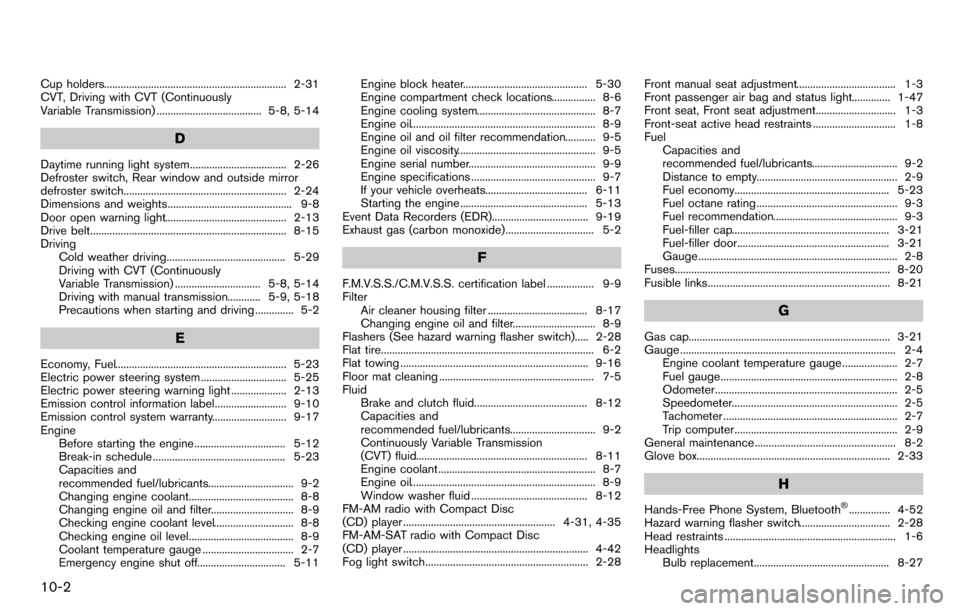
10-2
Cup holders.................................................................. 2-31
CVT, Driving with CVT (Continuously
Variable Transmission) ...................................... 5-8, 5-14
D
Daytime running light system................................... 2-26
Defroster switch, Rear window and outside mirror
defroster switch........................................................... 2-24
Dimensions and weights............................................. 9-8
Door open warning light............................................ 2-13
Drive belt....................................................................... 8-15
Driving Cold weather driving........................................... 5-29
Driving with CVT (Continuously
Variable Transmission) ............................... 5-8, 5-14
Driving with manual transmission............ 5-9, 5-18
Precautions when starting and driving .............. 5-2
E
Economy, Fuel.............................................................. 5-23
Electric power steering system ............................... 5-25
Electric power steering warning light .................... 2-13
Emission control information label.......................... 9-10
Emission control system warranty........................... 9-17
Engine Before starting the engine................................. 5-12
Break-in schedule ................................................ 5-23
Capacities and
recommended fuel/lubricants............................... 9-2
Changing engine coolant...................................... 8-8
Changing engine oil and filter.............................. 8-9
Checking engine coolant level............................. 8-8
Checking engine oil level...................................... 8-9
Coolant temperature gauge ................................. 2-7
Emergency engine shut off................................ 5-11 Engine block heater............................................. 5-30
Engine compartment check locations................ 8-6
Engine cooling system........................................... 8-7
Engine oil................................................................... 8-9
Engine oil and oil filter recommendation........... 9-5
Engine oil viscosity.................................................. 9-5
Engine serial number.............................................. 9-9
Engine specifications ............................................. 9-7
If your vehicle overheats..................................... 6-11
Starting the engine .............................................. 5-13
Event Data Recorders (EDR)................................... 9-19
Exhaust gas (carbon monoxide)................................ 5-2
F
F.M.V.S.S./C.M.V.S.S. certification label ................. 9-9
Filter Air cleaner housing filter .................................... 8-17
Changing engine oil and filter.............................. 8-9
Flashers (See hazard warning flasher switch)..... 2-28
Flat tire............................................................................. 6-2
Flat towing .................................................................... 9-16
Floor mat cleaning ........................................................ 7-5
Fluid Brake and clutch fluid......................................... 8-12
Capacities and
recommended fuel/lubricants............................... 9-2
Continuously Variable Transmission
(CVT) fluid.............................................................. 8-11
Engine coolant......................................................... 8-7
Engine oil................................................................... 8-9
Window washer fluid .......................................... 8-12
FM-AM radio with Compact Disc
(CD) player ....................................................... 4-31, 4-35
FM-AM-SAT radio with Compact Disc
(CD) player ................................................................... 4-42
Fog light switch........................................................... 2-28 Front manual seat adjustment.................................... 1-3
Front passenger air bag and status light.............. 1-47
Front seat, Front seat adjustment............................. 1-3
Front-seat active head restraints .............................. 1-8
Fuel Capacities and
recommended fuel/lubricants............................... 9-2
Distance to empty................................................... 2-9
Fuel economy........................................................ 5-23
Fuel octane rating ................................................... 9-3
Fuel recommendation............................................. 9-3
Fuel-filler cap......................................................... 3-21
Fuel-filler door....................................................... 3-21
Gauge ........................................................................ 2-8
Fuses.............................................................................. 8-20
Fusible links.................................................................. 8-21
G
Gas cap......................................................................... 3-21
Gauge .............................................................................. 2-4 Engine coolant temperature gauge .................... 2-7
Fuel gauge................................................................ 2-8
Odometer.................................................................. 2-5
Speedometer............................................................ 2-5
Tachometer ............................................................... 2-7
Trip computer........................................................... 2-9
General maintenance ................................................... 8-2
Glove box...................................................................... 2-33
H
Hands-Free Phone System, Bluetooth®............... 4-52
Hazard warning flasher switch................................. 2-28
Head restraints .............................................................. 1-6
Headlights Bulb replacement................................................. 8-27
Page 326 of 331
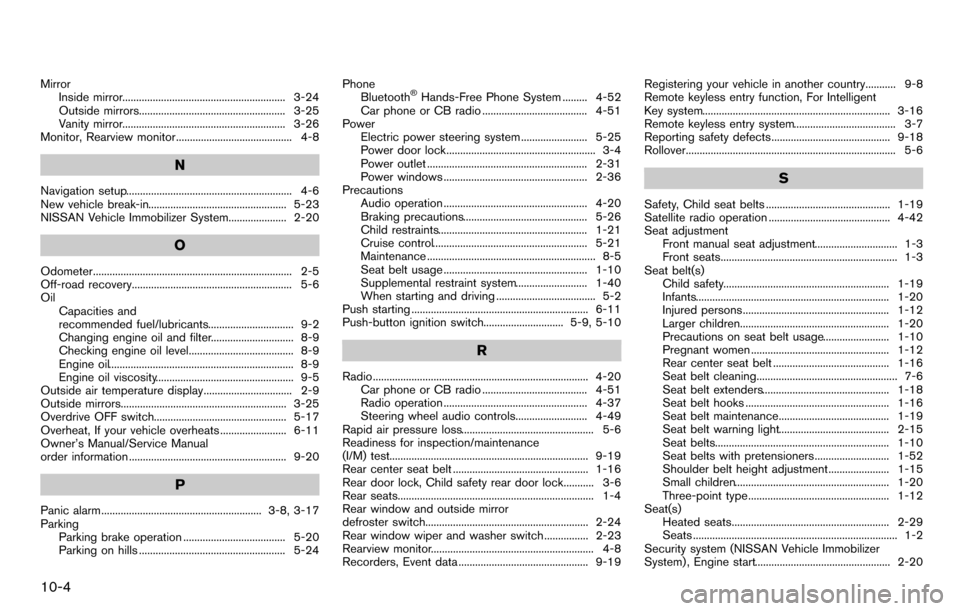
10-4
MirrorInside mirror........................................................... 3-24
Outside mirrors..................................................... 3-25
Vanity mirror........................................................... 3-26
Monitor, Rearview monitor.......................................... 4-8
N
Navigation setup............................................................ 4-6
New vehicle break-in.................................................. 5-23
NISSAN Vehicle Immobilizer System..................... 2-20
O
Odometer........................................................................ 2-5
Off-road recovery.......................................................... 5-6
Oil Capacities and
recommended fuel/lubricants............................... 9-2
Changing engine oil and filter.............................. 8-9
Checking engine oil level...................................... 8-9
Engine oil................................................................... 8-9
Engine oil viscosity.................................................. 9-5
Outside air temperature display................................ 2-9
Outside mirrors............................................................ 3-25
Overdrive OFF switch................................................ 5-17
Overheat, If your vehicle overheats ........................ 6-11
Owner’s Manual/Service Manual
order information ......................................................... 9-20
P
Panic alarm.......................................................... 3-8, 3-17
Parking Parking brake operation ..................................... 5-20
Parking on hills ..................................................... 5-24 Phone
Bluetooth
®Hands-Free Phone System ......... 4-52
Car phone or CB radio ...................................... 4-51
Power Electric power steering system ........................ 5-25
Power door lock...................................................... 3-4
Power outlet .......................................................... 2-31
Power windows .................................................... 2-36
Precautions Audio operation .................................................... 4-20
Braking precautions............................................. 5-26
Child restraints...................................................... 1-21
Cruise control........................................................ 5-21
Maintenance ............................................................. 8-5
Seat belt usage .................................................... 1-10
Supplemental restraint system.......................... 1-40
When starting and driving .................................... 5-2
Push starting ................................................................ 6-11
Push-button ignition switch............................. 5-9, 5-10
R
Radio.............................................................................. 4-20 Car phone or CB radio ...................................... 4-51
Radio operation .................................................... 4-37
Steering wheel audio controls.......................... 4-49
Rapid air pressure loss................................................ 5-6
Readiness for inspection/maintenance
(I/M) test........................................................................ 9-19
Rear center seat belt ................................................. 1-16
Rear door lock, Child safety rear door lock........... 3-6
Rear seats....................................................................... 1-4
Rear window and outside mirror
defroster switch........................................................... 2-24
Rear window wiper and washer switch ................ 2-23
Rearview monitor........................................................... 4-8
Recorders, Event data ............................................... 9-19 Registering your vehicle in another country........... 9-8
Remote keyless entry function, For Intelligent
Key system.................................................................... 3-16
Remote keyless entry system..................................... 3-7
Reporting safety defects........................................... 9-18
Rollover............................................................................ 5-6
S
Safety, Child seat belts ............................................. 1-19
Satellite radio operation ............................................ 4-42
Seat adjustment Front manual seat adjustment.............................. 1-3
Front seats................................................................ 1-3
Seat belt(s) Child safety............................................................ 1-19
Infants...................................................................... 1-20
Injured persons..................................................... 1-12
Larger children...................................................... 1-20
Precautions on seat belt usage........................ 1-10
Pregnant women .................................................. 1-12
Rear center seat belt .......................................... 1-16
Seat belt cleaning................................................... 7-6
Seat belt extenders.............................................. 1-18
Seat belt hooks .................................................... 1-16
Seat belt maintenance........................................ 1-19
Seat belt warning light........................................ 2-15
Seat belts............................................................... 1-10
Seat belts with pretensioners........................... 1-52
Shoulder belt height adjustment...................... 1-15
Small children........................................................ 1-20
Three-point type................................................... 1-12
Seat(s) Heated seats......................................................... 2-29
Seats .......................................................................... 1-2
Security system (NISSAN Vehicle Immobilizer
System) , Engine start................................................. 2-20